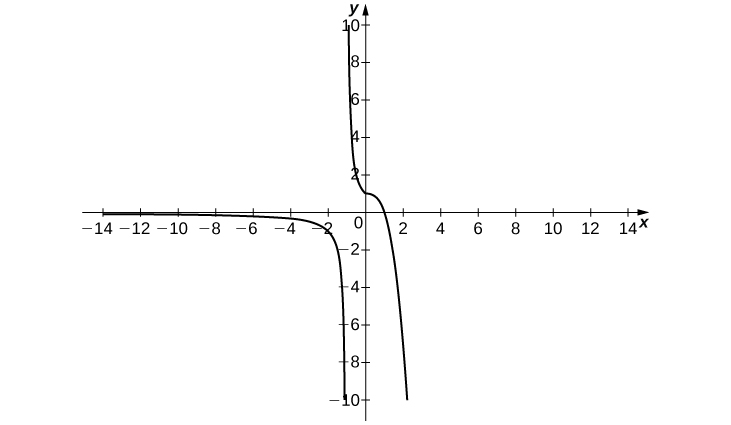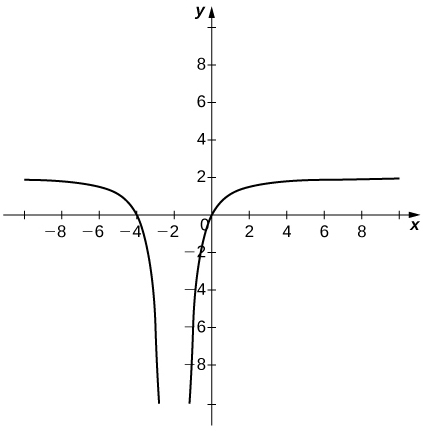For the following exercises (1-2), consider the function [latex]f(x)=\dfrac{x^2-1}{|x-1|}[/latex].
1. [T] Complete the following table for the function. Round your solutions to four decimal places.
| [latex]x[/latex] | [latex]f(x)[/latex] | [latex]x[/latex] | [latex]f(x)[/latex] | |
|---|---|---|---|---|
| 0.9 | a. | 1.1 | e. | |
| 0.99 | b. | 1.01 | f. | |
| 0.999 | c. | 1.001 | g. | |
| 0.9999 | d. | 1.0001 | h. |
2. What do your results in the preceding exercise indicate about the two-sided limit [latex]\underset{x\to 1}{\lim}f(x)[/latex]? Explain your response.
For the following exercises (3-5), consider the function [latex]f(x)=(1+x)^{1/x}[/latex].
3. [T] Make a table showing the values of [latex]f[/latex] for [latex]x=-0.01, \, -0.001, \, -0.0001, \, -0.00001[/latex] and for [latex]x=0.01, \, 0.001, \, 0.0001, \, 0.00001[/latex]. Round your solutions to five decimal places.
| [latex]x[/latex] | [latex]f(x)[/latex] | [latex]x[/latex] | [latex]f(x)[/latex] | |
|---|---|---|---|---|
| −0.01 | a. | 0.01 | e. | |
| −0.001 | b. | 0.001 | f. | |
| −0.0001 | c. | 0.0001 | g. | |
| −0.00001 | d. | 0.00001 | h. |
4. What does the table of values in the preceding exercise indicate about the function [latex]f(x)=(1+x)^{1/x}[/latex]?
5. To which mathematical constant does the limit in the preceding exercise appear to be getting closer?
In the following exercises (6-8), use the given values of [latex]x[/latex] to set up a table to evaluate the limits. Round your solutions to eight decimal places.
6. [T] [latex]\underset{x\to 0}{\lim}\dfrac{\sin 2x}{x}; \, x = \pm 0.1, \, \pm 0.01, \, \pm 0.001, \, \pm 0.0001[/latex]
| [latex]x[/latex] | [latex]\frac{\sin 2x}{x}[/latex] | [latex]x[/latex] | [latex]\frac{\sin 2x}{x}[/latex] |
|---|---|---|---|
| −0.1 | a. | 0.1 | e. |
| −0.01 | b. | 0.01 | f. |
| −0.001 | c. | 0.001 | g. |
| −0.0001 | d. | 0.0001 | h. |
7. [T] [latex]\underset{x\to 0}{\lim}\dfrac{\sin 3x}{x}; \, x = \pm 0.1, \, \pm 0.01, \, \pm 0.001, \, \pm 0.0001[/latex]
| X | [latex]\frac{\sin 3x}{x}[/latex] | [latex]x[/latex] | [latex]\frac{\sin 3x}{x}[/latex] |
|---|---|---|---|
| −0.1 | a. | 0.1 | e. |
| −0.01 | b. | 0.01 | f. |
| −0.001 | c. | 0.001 | g. |
| −0.0001 | d. | 0.0001 | h. |
8. Use the preceding two exercises to conjecture (guess) the value of the following limit: [latex]\underset{x\to 0}{\lim}\dfrac{\sin ax}{x}[/latex] for [latex]a[/latex], a positive real value.
In the following exercises (9-14), set up a table of values to find the indicated limit. Round to eight digits.
9. [T] [latex]\underset{x\to 2}{\lim}\dfrac{x^2-4}{x^2+x-6}[/latex]
| [latex]x[/latex] | [latex]\frac{x^2-4}{x^2+x-6}[/latex] | [latex]x[/latex] | [latex]\frac{x^2-4}{x^2+x-6}[/latex] |
|---|---|---|---|
| 1.9 | a. | 2.1 | e. |
| 1.99 | b. | 2.01 | f. |
| 1.999 | c. | 2.001 | g. |
| 1.9999 | d. | 2.0001 | h. |
10. [T] [latex]\underset{x\to 1}{\lim}(1-2x)[/latex]
| [latex]x[/latex] | [latex]1-2x[/latex] | [latex]x[/latex] | [latex]1-2x[/latex] |
|---|---|---|---|
| 0.9 | a. | 1.1 | e. |
| 0.99 | b. | 1.01 | f. |
| 0.999 | c. | 1.001 | g. |
| 0.9999 | d. | 1.0001 | h. |
11. [T] [latex]\underset{x\to 0}{\lim}\dfrac{5}{1-e^{1/x}}[/latex]
| [latex]x[/latex] | [latex]\frac{5}{1-e^{1/x}}[/latex] | [latex]x[/latex] | [latex]\frac{5}{1-e^{1/x}}[/latex] |
|---|---|---|---|
| −0.1 | a. | 0.1 | e. |
| −0.01 | b. | 0.01 | f. |
| −0.001 | c. | 0.001 | g. |
| −0.0001 | d. | 0.0001 | h. |
12. [T] [latex]\underset{z\to 0}{\lim}\dfrac{z-1}{z^2(z+3)}[/latex]
| [latex]z[/latex] | [latex]\frac{z-1}{z^2(z+3)}[/latex] | [latex]z[/latex] | [latex]\frac{z-1}{z^2(z+3)}[/latex] |
|---|---|---|---|
| −0.1 | a. | 0.1 | e. |
| −0.01 | b. | 0.01 | f. |
| −0.001 | c. | 0.001 | g. |
| −0.0001 | d. | 0.0001 | h. |
13. [T] [latex]\underset{t\to 0^+}{\lim}\dfrac{\cos t}{t}[/latex]
| [latex]t[/latex] | [latex]\frac{\cos t}{t}[/latex] |
|---|---|
| 0.1 | a. |
| 0.01 | b. |
| 0.001 | c. |
| 0.0001 | d. |
14. [T] [latex]\underset{x\to 2^-}{\lim}\dfrac{1-\frac{2}{x}}{x^2-4}[/latex]
| [latex]x[/latex] | [latex]\frac{1-\frac{2}{x}}{x^2-4}[/latex] | [latex]x[/latex] | [latex]\frac{1-\frac{2}{x}}{x^2-4}[/latex] |
|---|---|---|---|
| 1.9 | a. | 2.1 | e. |
| 1.99 | b. | 2.01 | f. |
| 1.999 | c. | 2.001 | g. |
| 1.9999 | d. | 2.0001 | h. |
In the following exercises (15-16), set up a table of values and round to eight significant digits. Based on the table of values, make a guess about what the limit is. Then, use a calculator to graph the function and determine the limit. Was the conjecture correct? If not, why does the method of tables fail?
15. [T] [latex]\underset{\theta \to 0^-}{\lim}\sin \left(\frac{\pi }{\theta }\right)[/latex]
| θ | [latex]\sin (\frac{\pi }{\theta })[/latex] | θ | [latex]\sin (\frac{\pi }{\theta })[/latex] |
|---|---|---|---|
| −0.1 | a. | 0.1 | e. |
| −0.01 | b. | 0.01 | f. |
| −0.001 | c. | 0.001 | g. |
| −0.0001 | d. | 0.0001 | h. |
16. [T] [latex]\underset{\alpha \to 0^+}{\lim}\frac{1}{\alpha} \cos \left(\frac{\pi }{\alpha }\right)[/latex]
| [latex]a[/latex] | [latex]\frac{1}{\alpha } \cos (\frac{\pi }{\alpha })[/latex] |
|---|---|
| 0.1 | a. |
| 0.01 | b. |
| 0.001 | c. |
| 0.0001 | d. |
In the following exercises (17-20), consider the graph of the function [latex]y=f(x)[/latex] shown here. Which of the statements about [latex]y=f(x)[/latex] are true and which are false? Explain why a statement is false.
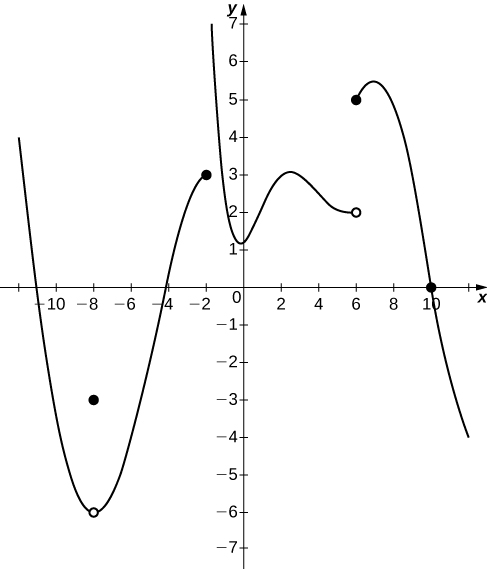
17. [latex]\underset{x\to 10^-}{\lim}f(x)=0[/latex]
18. [latex]\underset{x\to -2^+}{\lim}f(x)=3[/latex]
19. [latex]\underset{x\to -8^+}{\lim}f(x)=f(-8)[/latex]
20. [latex]\underset{x\to 6}{\lim}f(x)=5[/latex]
In the following exercises (21-24), use the following graph of the function [latex]y=f(x)[/latex] to find the values, if possible. Estimate when necessary.
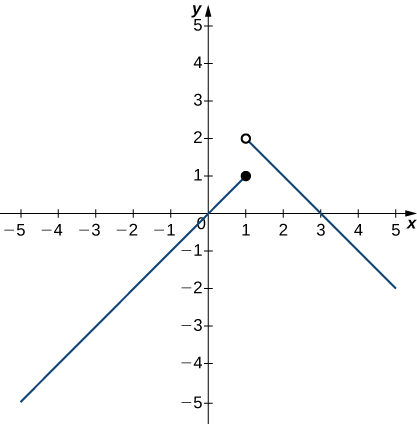
21. [latex]\underset{x\to 1^-}{\lim}f(x)[/latex]
22. [latex]\underset{x\to 1^+}{\lim}f(x)[/latex]
23. [latex]\underset{x\to 1}{\lim}f(x)[/latex]
In the following exercises (26-29), use the graph of the function [latex]y=f(x)[/latex] shown here to find the values, if possible. Estimate when necessary.
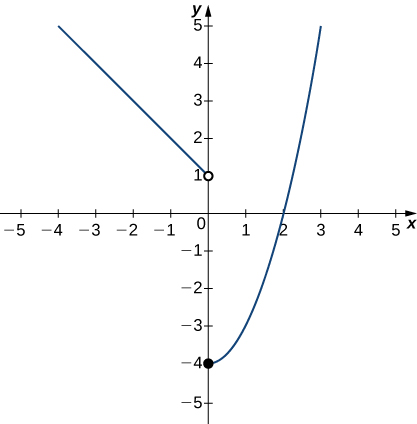
26. [latex]\underset{x\to 0^-}{\lim}f(x)[/latex]
27. [latex]\underset{x\to 0^+}{\lim}f(x)[/latex]
28. [latex]\underset{x\to 0}{\lim}f(x)[/latex]
29. [latex]\underset{x\to 2}{\lim}f(x)[/latex]
In the following exercises (30-35), use the graph of the function [latex]y=f(x)[/latex] shown here to find the values, if possible. Estimate when necessary.
![A graph of a piecewise function with three segments, all linear. The first exists for x < -2, has a slope of 1, and ends at the open circle at (-2, 0). The second exists over the interval [-2, 2], has a slope of -1, goes through the origin, and has closed circles at its endpoints (-2, 2) and (2,-2). The third exists for x>2, has a slope of 1, and begins at the open circle (2,2).](https://s3-us-west-2.amazonaws.com/courses-images/wp-content/uploads/sites/2332/2018/01/11202943/CNX_Calc_Figure_02_02_204.jpg)
30. [latex]\underset{x\to -2^-}{\lim}f(x)[/latex]
31. [latex]\underset{x\to -2^+}{\lim}f(x)[/latex]
32. [latex]\underset{x\to -2}{\lim}f(x)[/latex]
33. [latex]\underset{x\to 2^-}{\lim}f(x)[/latex]
34. [latex]\underset{x\to 2^+}{\lim}f(x)[/latex]
35. [latex]\underset{x\to 2}{\lim}f(x)[/latex]
In the following exercises (36-38), use the graph of the function [latex]y=g(x)[/latex] shown here to find the values, if possible. Estimate when necessary.
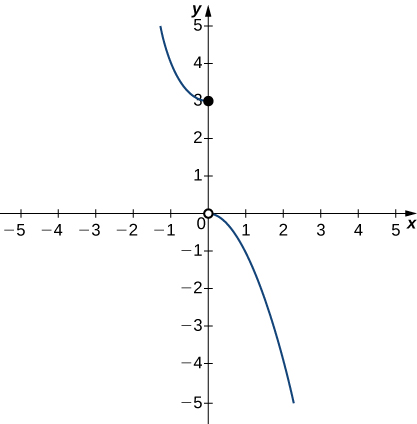
36. [latex]\underset{x\to 0^-}{\lim}g(x)[/latex]
37. [latex]\underset{x\to 0^+}{\lim}g(x)[/latex]
38. [latex]\underset{x\to 0}{\lim}g(x)[/latex]
In the following exercises (39-41), use the graph of the function [latex]y=h(x)[/latex] shown here to find the values, if possible. Estimate when necessary.
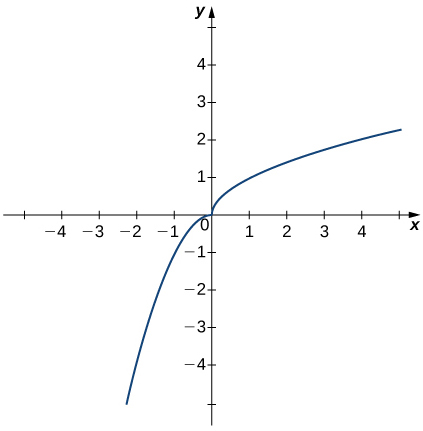
39. [latex]\underset{x\to 0^-}{\lim}h(x)[/latex]
40. [latex]\underset{x\to 0^+}{\lim}h(x)[/latex]
41. [latex]\underset{x\to 0}{\lim}h(x)[/latex]
In the following exercises (42-46), use the graph of the function [latex]y=f(x)[/latex] shown here to find the values, if possible. Estimate when necessary.
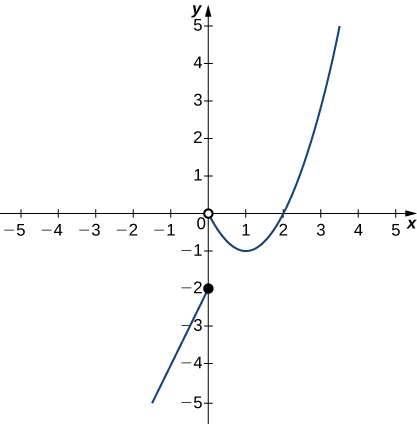
42. [latex]\underset{x\to 0^-}{\lim}f(x)[/latex]
43. [latex]\underset{x\to 0^+}{\lim}f(x)[/latex]
44. [latex]\underset{x\to 0}{\lim}f(x)[/latex]
45. [latex]\underset{x\to 1^-}{\lim}f(x)[/latex]
46. [latex]\underset{x\to 2^+}{\lim}f(x)[/latex]
In the following exercises (47-51), sketch the graph of a function with the given properties.
47. [latex]\underset{x\to 2}{\lim}f(x)=1, \, \underset{x\to 4^-}{\lim}f(x)=3[/latex], [latex]\underset{x\to 4^+}{\lim}f(x)=6, \, f(4)[/latex] is not defined.
48. [latex]\underset{x\to -\infty }{\lim}f(x)=0, \, \underset{x\to -1^-}{\lim}f(x)=−\infty[/latex], [latex]\underset{x\to -1^+}{\lim}f(x)=\infty, \, \underset{x\to 0}{\lim}f(x)=f(0), \, f(0)=1, \, \underset{x\to \infty }{\lim}f(x)=−\infty[/latex]
49. [latex]\underset{x\to -\infty}{\lim}f(x)=2, \, \underset{x\to 3^-}{\lim}f(x)=−\infty[/latex], [latex]\underset{x\to 3^+}{\lim}f(x)=\infty, \, \underset{x\to \infty }{\lim}f(x)=2, \, f(0)=-\frac{1}{3}[/latex]
50. [latex]\underset{x\to -\infty }{\lim}f(x)=2, \, \underset{x\to -2}{\lim}f(x)=−\infty[/latex],[latex]\underset{x\to \infty }{\lim}f(x)=2, \, f(0)=0[/latex]
51. [latex]\underset{x\to -\infty }{\lim}f(x)=0, \, \underset{x\to -1^-}{\lim}f(x)=\infty, \, \underset{x\to -1^+}{\lim}f(x)=−\infty, \, f(0)=-1, \, \underset{x\to 1^-}{\lim}f(x)=−\infty, \, \underset{x\to 1^+}{\lim}f(x)=\infty, \, \underset{x\to \infty }{\lim}f(x)=0[/latex]
52. Shock waves arise in many physical applications, ranging from supernovas to detonation waves. A graph of the density of a shock wave with respect to distance, [latex]x[/latex], is shown here. We are mainly interested in the location of the front of the shock, labeled [latex]x_{SF}[/latex] in the diagram.
a. Evaluate [latex]\underset{x\to x_{SF}^+}{\lim}\rho(x)[/latex]
b. Evaluate [latex]\underset{x\to x_{SF}^-}{\lim}\rho(x)[/latex]
c. Evaluate [latex]\underset{x\to x_{SF}}{\lim}\rho(x)[/latex]. Explain the physical meanings behind your answers.
53. A track coach uses a camera with a fast shutter to estimate the position of a runner with respect to time. A table of the values of position of the athlete versus time is given here, where [latex]x[/latex] is the position in meters of the runner and [latex]t[/latex] is time in seconds. What is [latex]\underset{t\to 2}{\lim}x(t)[/latex]? What does it mean physically?
| [latex]t[/latex] (sec) | [latex]x[/latex] (m) |
|---|---|
| 1.75 | 4.5 |
| 1.95 | 6.1 |
| 1.99 | 6.42 |
| 2.01 | 6.58 |
| 2.05 | 6.9 |
| 2.25 | 8.5 |
Candela Citations
- Calculus Volume 1. Authored by: Gilbert Strang, Edwin (Jed) Herman. Provided by: OpenStax. Located at: https://openstax.org/details/books/calculus-volume-1. License: CC BY-NC-SA: Attribution-NonCommercial-ShareAlike. License Terms: Access for free at https://openstax.org/books/calculus-volume-1/pages/1-introduction
![A graph of the function (1/alpha) * cos (pi / alpha), which oscillates gently until the interval [-.2, .2], where it oscillates rapidly, going to infinity and negative infinity as it approaches the y axis.](https://s3-us-west-2.amazonaws.com/courses-images/wp-content/uploads/sites/2332/2018/01/11202929/CNX_Calc_Figure_02_02_214.jpg)
